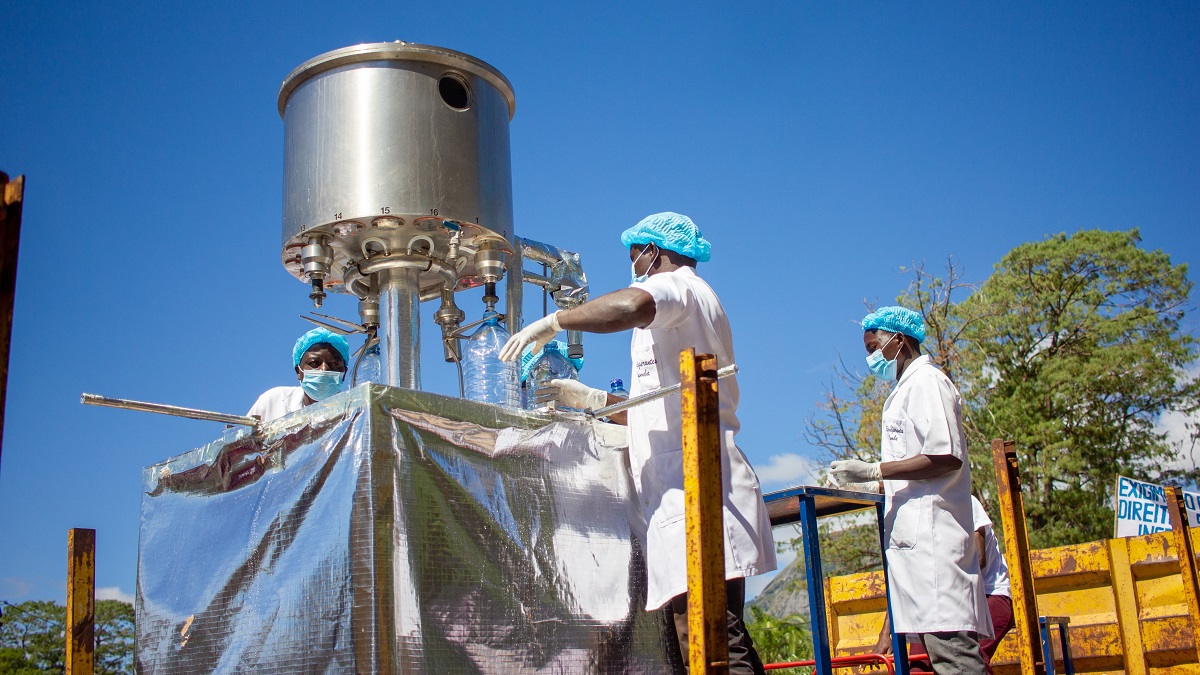By Paul Akiwumi, Director for Africa and Least Developed Countries, UNCTAD and Ratnakar Adhikari, Executive Director, Enhanced Integrated Framework

© Shutterstock/Ivan Bruno de M | Workers handling a mineral water filler machine in Manica, Mozambique.
Over the past two decades, the 46 least developed countries (LDCs) have recorded relatively robust economic growth, averaging an annual rate of 5.7% from 2001 to 2019. However, this growth has not necessarily translated into improved development outcomes: many LDCs are still plagued by poverty, food insecurity and inequality.
These conditions worsened during the COVID-19 pandemic, when LDCs registered their worst socio-economic performance since the 1980s. Barring a few exceptions, LDCs have a limited capacity to react to exogenous shocks, which makes their socio-economic progress fragile. A number of factors undermine their resilience, notably limited economic diversification and human capital development and weak production systems.
This situation can be explained by a low level of productive capacities. These are the productive resources, entrepreneurial capabilities and production linkages that determine a country’s ability to produce goods and services that, ultimately, help it grow and develop. The figure below demonstrates the positive correlation between UNCTAD’s Productive Capacity Index (PCI) and gross domestic product per capita.
UNCTAD’s index reveals that LDCs have the weakest productive capacities in the world, with a median productive capacity index (PCI) score of 23.6, compared to 32.4 for other developing countries. Furthermore, LDCs lag behind other developing countries across all PCI sub-categories, including natural capital, human capital, energy, ICTs, transport, private sector, institutions and structural change.
Labour productivity in LDCs has also slowed down over the last decade – a direct consequence of weak productive capacities – which has put a ceiling on their development potential. This was especially pronounced in Central African Republic, Gambia, Yemen and Timor-Leste, which have contended with conflicts, natural disasters and extreme levels of oil dependence. Meanwhile, the recession induced by the pandemic did not help, as many urban workers lost their jobs in the manufacturing and service sectors. For women and youth in particular, the economic damage of the pandemic resulted in a loss of income, owing to a reduction of hours and opportunities for self-employed or informal workers, particularly in trade, tourism and domestic and personal services.
As the deadline for the 2030 Agenda for Sustainable Development draws closer and LDCs face further challenges caused by the war in Ukraine, climate change and other unforeseen shocks, it is vital to put productive capacities at the heart of every development strategy.
A path towards structural transformation
UNCTAD’s research confirms that structural transformation driven by productive capacities is the only long-term solution to LDCs’ vulnerabilities. Over time, a country’s resources should move from low productivity areas to high productivity ones, enabling long-term growth, generating jobs and increasing incomes – all necessary factors for sustainable development.
Asian LDCs such as Lao People’s Democratic Republic and Cambodia experienced some progress towards achieving structural transformation over the past twenty years by focusing on high-productivity knowledge-intensive activities in services and the manufacturing sector.
Sustainable Development Goal 9 on resilient infrastructure and sustainable industrialisation emphasises the need for LDCs to accelerate their economies’ transition from agriculture and natural resources to manufacturing-based structures. Currently, agriculture still plays a major role in LDC economies, accounting for 22% of output, while manufacturing contributes 13% – against 8% and 23%, respectively, in other developing countries. As of 2019, 55% of LDCs’ workforce was still employed in agriculture.
LDCs can start building their productive capacities by transitioning from low productivity agriculture to higher productivity activities, like manufacturing. The first step is to add value to the agricultural sector through agro-processing. When they are sold raw, agricultural products fetch less on global and regional markets. Increasing LDCs’ capacity to process their products, like drying their mangos, powdering their seaweed or making shea butter, brings them one step closer towards small-scale manufacturing.
Burkina Faso, for instance, saw a 50% increase in their dried mango export revenues when they improved their drying capacities. Burkinabe dried mango now enjoys a 25% market share in Europe thanks to the steady industrialisation of its mango processing industry.
Developing productive capacities in a challenging decade
This decade comes with a host of challenges for LDCs. Recovery efforts and growth prospects across the world are limited. Further, rising fuel and food prices are threatening to send marginalised populations into chronic poverty. These external shocks highlight the need for development strategies that rely on resilience-building efforts to promote long-term growth.
Implementing these will require support. LDC governments are faced with the challenging task of mitigating the effects of external shocks, while concurrently investing in productive capacity-building activities that are aimed at improving livelihoods and reducing vulnerability.
Targeted policies, including investing in infrastructure and human capital, should be implemented to support productive capacities-induced structural transformation. Each LDC has its own political, socio-economic context and institutional background, which will determine how productive capacities can best be utilised and developed.
However, all LDCs should look to create viable manufacturing hubs or expand their service sectors, through tourism or e-commerce, to kickstart entrepreneurship and accelerate industrial development. This will form the basis for the development of productive activities in other sectors, such as infrastructure and technology. For instance, in Malawi, the Government created special economic zones to fast-track industrialisation, including an Agro-processing Special Economic Zone. Meanwhile in Burkina Faso, shea producers and processors are moving up the shea value chain by upgrading their equipment and updating their product labelling and packaging, which has increased their exports to European countries.
Building forward and backward production linkages between agricultural and manufacturing sectors by adding value to primary commodities should be a priority for LDCs. Taking incremental steps towards industrialisation through increased productive capacities, with the support of development partners, will ensure that progress will be sustainable and robust, truly leading LDCs along the path of development.
The article was first published on 7 October 2022 by OECD’s Development Matters blog.


